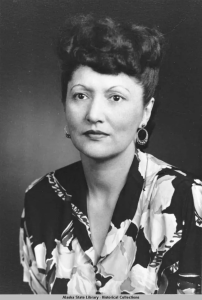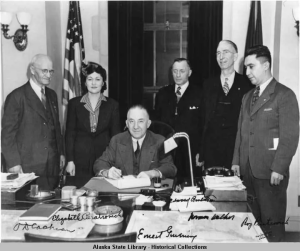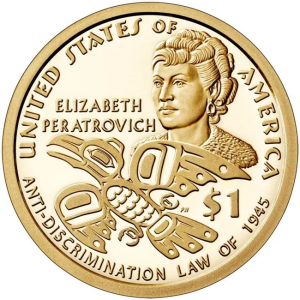10 The 19th Amendment, Elizabeth Peratrovich, and the Ongoing Fight for Equal Rights
Erik Johnson

The 19th Amendment, which granted American women the right to vote, was passed by Congress in 1919, ratified by the states on August 18, 1920, and adopted as a part of the U.S. Constitution on August 26, 1920.[1] Over the course of 2020, the National Park Service and other organizations commemorated the centennial of this important political achievement that changed the U.S. Constitution.
Like many Amendments to the Constitution, the 19th Amendment was a part of the ongoing struggle for equal rights. It provided suffrage for American women, but these rights did not extend to Indigenous women (or men), who were not considered citizens until 1924 and then routinely disenfranchised through various schemes such as the 1925 Alaska Literacy Law. The 19th Amendment also did not necessarily provide the ballot to other women (or men) of color, who also encountered continual voter disenfranchisement. Access to the ballot and equal rights was and has been an ongoing struggle led by diverse women throughout the country.

In Alaska, women’s suffrage passed in 1913—seven years prior to the 19th Amendment—and antidiscrimination legislation passed nearly 20 years prior to the major national civil rights bills of the 1960s.[2] In the 1940s, Elizabeth Peratrovich—a Tlingit woman who was Grand President of the Alaska Native Sisterhood—led the charge to end discrimination against Alaska Natives.[3] She was fed up with Indigenous people paying taxes and fighting wars for America but not receiving the same rights and access to businesses as white citizens.
The Alaska Equal Rights Act legislation originally was brought to the Alaska legislature in 1943 but failed. When the bill was taken up by the Alaska legislature again, in 1945, Peratrovich left a lasting mark when she challenged the discriminatory and racist comments expressed by Senator Allen Shattuck. Shattuck bemoaned the notion of equality among whites and Alaska Natives:

“The races should be kept further apart. Who are these people, barely out of savagery, who want to associate with us whites with 5,000 years of recorded civilization behind us?”
When the floor opened to comment from the public, Peratrovich reportedly set down her knitting needles and countered Shattuck:
“I would not have expected that I, who am barely out of savagery, would have to remind gentlemen with five thousand years of recorded civilization behind them of our Bill of Rights.”
Her speech went on to mention the injustices faced by her family, including the inability to acquire decent housing. Enough senators were moved by Peratrovich’s speech that the Alaska Equal Rights Act of 1945 was passed and then signed by Governor Ernest Gruening. Gruening was on record saying that the bill never would have passed without Peratrovich’s efforts.[4]
Alaska recognizes February 16th (the date the Alaska Equal Rights Act was signed) as “Elizabeth Peratrovich Day, and the U.S. Mint commemorated her on the one-dollar coin during 2020, which was the 75th anniversary of the landmark antidiscrimination legislation in Alaska. For Peratrovich and the Alaska Native Sisterhood, the Alaska Equal Rights Act was not the end of the fight for equal rights and the improvement of Alaska Natives’ lives—it was only one component of a longer struggle.[5]
It is important to commemorate the passage of the 19th Amendment, which required generations of lobbying and sacrifice, and to recognize the numerous contributions of female leaders as the quest for gender equality continues with work left to do.
The Equal Rights Amendment, which was originally drafted in 1923, finally met the ratification threshold in January 2020. The language in the amendment states: “Equality of rights under the law shall not be denied or abridged by the United States or by any state on account of sex. The Congress shall have the power to enforce, by appropriate legislation, the provisions of this article.” Because efforts to secure the approval of the 75% of states needed to ratify the amendment have seen the passing of so many decades, some states have rescinded prior approval, and now there are obstacles to ratification that must be settled by Congress and the courts.
Source:
Johnson, Erik. “The 19th Amendment, Elizabeth Peratrovich, and the Ongoing Fight for Equal Rights,” National Park Service: Articles, 2021
- Tennessee became the 36th state to ratify the amendment. Amendments to the Constitution require three-fourths of the states to approve (there were only 48 states in 1920). Numerous attempts to pass a women's [pb_glossary id="214"]suffrage [/pb_glossary]amendment had failed to pass Congress for over 40 years. ↵
- Much national civil rights progress occurred in the 1960s, including the Civil Rights Act of 1964, which accomplished extensive measures to end racial discrimination, and the Voting Rights Act of 1965, which was a major step toward ending voter disenfranchisement. ↵
- The Alaska Native Sisterhood formed in 1914 and fought for citizenship and voting rights alongside the Alaska Native Brotherhood. ↵
- Holly Miowak Guise, "Elizabeth Peratrovich, the Alaska Native Sisterhood, and Indigenous Women's Activism, 1943-1947," in Suffrage at 100: Women in American Politics Since 1920, ed. Stacie Taranto and Leandra Zarnow (Baltimore: Johns Hopkins Press, 2020 ), 148-152. ↵
- Guise, "Peratrovich" in Suffrage at 100, 153. ↵
Prevented membership; kept out of a social and/or financial group.

